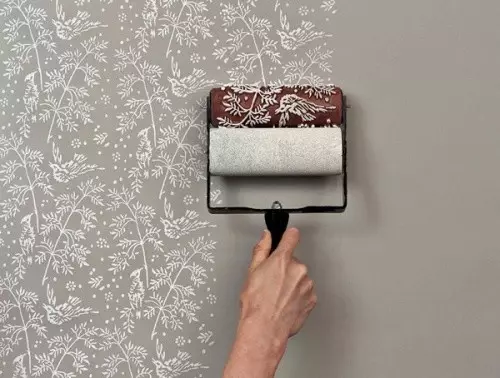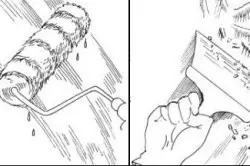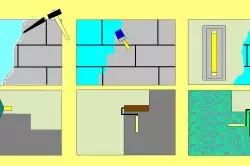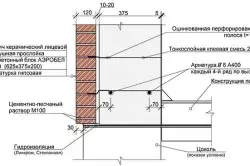Painting of walls during repairs is one of the most convenient, cheap and functional solutions. You can wash the painted wall without obstacles and clean, you can repaint it in another color if you wish. In addition, with paint, you can even create a specific pattern or relief on the surface.

The best option for painting is the water-making paint for walls and ceilings.
The most optimal choice is the water-making paint for walls and ceilings. It is very persistent, relatively quickly dries. Yes, and the latitude of the range of choice is sufficient for every taste. But the painting of the walls with their own hands can be carried out only after complete preparation and pre-treatment of the surface of the walls.
Features of dismantling old coatings

The removal scheme of old paint.
We begin with the removal of old coatings. So, if you have a wall covered with lime or whitewash, you need to get well all this with a rigid sponge and completely removed. In the event that the layer is quite thick, the spatula is applied. However, after removing thick pieces, the erosion will have to do anyway, since even the minimum remnants of whitewings on the wall can prevent a good overlay of new paint.
If your wall is saved by wallpaper, you need to remove them. Moreover, it is not only wallpaper, but also a paper layer, which can be passed under them. It is advisable to preliminarily wet the wallpaper and give them a little flush, after which they will easily take off. If the wallpaper on the wall of hot embossing, then this method will not help, you will have to act manually or with a spatula. And if things are very bad, it is advisable in the construction supermarket to purchase a special tool that makes it easier to remove the old wallpaper layer.
It is very often encountered to remove the old paint from the wall. This, perhaps, is most of all hassle on the dismantling of the old coating. If the paint is old enough and radiates itself, then you will easily cope with it with a metal sharp spatula. But it happens that the layer of paint is thin and lies quite firmly. Then it is not necessary to do without a special means to remove paint or a construction dryer. From the hair dryer a lot of dust, therefore it is still better to stay on a special solvent. It is simply applied to the surface with a tassel, and after a few minutes, the coating starts swell, after which it is fairly easily removed.
It should be noted that after removing any coating from the wall it is advisable to remove the spatula old layers of putty and plaster.
It must be done in those places where they are too old and are already beginning to lag behind. If this is not done, then in these places they will begin to swell under the paint, which will spoil the decorative of the coating.
Article on the topic: How to properly paint the ceiling of waterfront paint
Back to the category
Restoration of the wall surface in front of the color

Wall plastering and painting pattern.
When the old coating is completely dismantled and cleaned, it is necessary to clean the entire wall using an iron brush for metal. It will remove dust, and will also help remove moldness and fungus in problem places. After such a reception, you will be clearly seen, which tickets on the wall require restoration before painting.
The next stage of work is the repair of the wall. It should be started with a thorough primer. For these purposes, it is better to choose a special primer that kills the fungus and will serve as a reliable protection from its appearance. After it is absorbed into the surface, you can be taken for restoration.
For a start, a thick cement solution is divorced, with which all large cracks are embarcled and potholes in the wall. It is especially close to them if the wall is another side goes to the street, since cold air can penetrate through such defects and even moisture. When plastering, you need to level the surface immediately and rub it, wasting a spatula in water and cement.
When the plaster is completely dry and grabbed, you need to thoroughly grind the wall again. This will secure the result and prepare it to a new layer - putty. The putty is better to choose a versatile. As for application, it is applied completely throughout the area of the wall, in contrast to the plaster mortar. The putty aligns well and protects the surface, as a result of which you for a long time you will not experience problems about the crepe paint. It is convenient to distribute spacure with a rubber spatula. But after its complete drying, it is still recommended to sand the wall with sandpaper, after which the dust formed is to be shifted. After all, painting requires the most smooth surface.
Article on the topic: How to replace the light switch?
Special attention should be paid to one very important and problematic question, which concerns rusty spots on the walls. This is not at all uncommon. Such stains more or lesser extent have the property to come in each room. And be sure to fight with them, as they have a property in a short time to come across wallpaper, and through the water-level paint. And it spoils the view.
So, if there is only the occasionally small rust specks on the wall, then it is better to pinch them with a good layer of oil white paint, usually helps. But for greater loyalty, experts recommend using acrylic primer. It is specifically designed to eliminate such defects. Moreover, its use is necessary when rust valves are damaged by significant areas on the walls.
Back to the category
Supported materials and painting tools

Scheme of warm and cold colors.
Now, when the wall is prepared, it is necessary to brand it again, and then move it directly to painting. But first you need to purchase main materials and tools for work. You will need:
- a couple of tassels with combined bristle for proscuration of problem places;
- roller If you want a smooth surface, choose a porolon roller or a short pile. If you plan to be visible to the structure, get a roller with a long texture of the pile;
- Water-emulsion paint. When buying, keep in mind that for the bathroom, the ideal option will be silicone water-emulsion paint. Latex, and its acrylic types are perfectly suitable for ordinary rooms;
- a bucket with hot water to maintain the level of humidity;
- rags for wiping hands if necessary;
- Respirator to protect the respiratory tract.
Back to the category
Wall cover with do-it-yourself

Scheme painting a brick wall.
Article on the topic: How to glue vinyl wallpaper on a fliesline basis: the right video, what glue is better, Italy, reviews and characteristics, damage, photo
Now you can go to the main process. In advance, it is important to properly prepare the room. The optimal humidity should be at about 75%. Then the paint will dry uniformly. When dry dryness, a bucket with boiling water is used, which is simply necessary to put into the center of the room. The air temperature for high-quality painting of walls should be kept at about 17 ° C. It is not allowed both heat and cold. But at the same time open the vents can be, provided that the necessary temperature in the room is not broken.
Start painting need to start from the corners from top to bottom. At the same time, along the edges, at the top and below, it is necessary to leave non-rapid stripes about 15 cm. They are better to bite their brush. On the side of the roller, you do not need to drive, as a divorce will be visible. Try also not to pick up too much paint immediately on the roller. To make it not, it is good to use a special paint bath, which regulates its amount on a roller or brush. After painting the main surface of the brush, the remaining places are squeezed.
Now you need to wait until the first layer dry completely. Then you can go over the surface again. And when everything dries, it can be stated that the painting of the walls is over. Water-emulsion paint for walls of any type does not require any additional processing, so you can not worry about the coating resistance.
